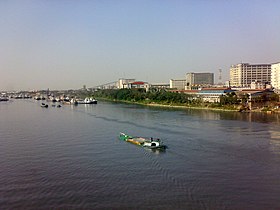Port of Narayanganj
| Port of Narayanganj | |
|---|---|
 Ships on the Shitalakshya River beside the Kanchpur Industrial Area in Narayanganj | |
 Click on the map for a fullscreen view | |
| Location | |
| Country | Bangladesh |
| Location | Narayanganj District, Dhaka Division |
| Coordinates | 23°37′01″N 90°30′22″E / 23.617°N 90.506°E |
| UN/LOCODE | BGNAR[1] |
| Details | |
| Opened | 1862 |
| Operated by | Bangladesh Inland Water Transport Authority |
| Owned by | Government of Bangladesh |
| Type of harbour | Artificial / Natural |
| No. of wharfs | 17 |
The Port of Narayanganj is a
History

The port formally began operations in 1862. Narayanganj was the principal gateway to
Rally Brothers & Co. was the first company to begin the jute business in the port of Narayanganj. Numerous British companies set up trading posts in the area and used middlemen, called beparis, to source raw jute from the hinterland. A
The present-day Metropolitan Chamber of Commerce and Industry (MCCI) in Bangladesh has its roots in the Narayanganj Chamber of Commerce (NCC) established in 1904.[7]
Port facilities
The port has a two-storied terminal building, seven RCC jetties, ten pontoon jetties and a number of warehouses covering a total floor space of 62,000 sq ft.[3] The port is linked with Dhaka by the Bangladesh Railway and three roads.
Industry
The port's surroundings are a vital manufacturing center of Bangladesh, including for the
See also
- Countries dependent on the Bay of Bengal
References
- ^ "UNLOCODE (BD) - BANGLADESH". service.unece.org. Retrieved 22 April 2020.
- ^ "There were 20 firms at Narayanganj in 1907-08 engaged in the purchase, bailing and supply of raw jute to Calcutta mills. Of these, 18 were in European and two in Indian ownership."https://en.banglapedia.org/index.php/Narayanganj
- ^ a b c "Narayanganj". Banglapedia. Retrieved 2017-07-25.
- ^ Ashfaqur Rahman (2012-06-10). "Queen Elizabeth II: An enabling monarch". The Daily Star. Retrieved 2017-07-25.
- ^ "The Adamjee Gallery | Pacific Multi Products Pvt Ltd". Pmp.com.pk. Retrieved 2017-07-25.
- ^ "History Wars: Kamal Hossain Interview (Part 1)". 11 July 2014.
- ISBN 978-984-33-8235-1. Archived from the original(PDF) on 29 November 2021.
- ^ "Narayanganj | Bangladesh". Encyclopædia Britannica. Retrieved 2017-07-25.
